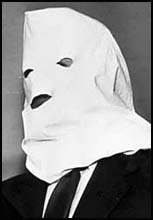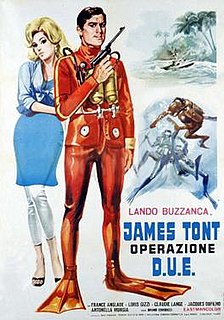Espionage, spying or intelligence gathering is the act of obtaining secret or confidential information (intelligence) from non-disclosed sources or divulging of the same without the permission of the holder of the information for a tangible benefit. A person who commits espionage is called an espionage agent or spy. Any individual or spy ring, in the service of a government, company, criminal organization, or independent operation, can commit espionage. The practice is clandestine, as it is by definition unwelcome. In some circumstances, it may be a legal tool of law enforcement and in others, it may be illegal and punishable by law.

Harold Adrian Russell "Kim" Philby was a British intelligence officer and a double agent for the Soviet Union. In 1963 he was revealed to be a member of the Cambridge Five, a spy ring which had divulged British secrets to the Soviets during World War II and in the early stages of the Cold War. Of the five, Philby is believed to have been most successful in providing secret information to the Soviets.
Spy fiction is a genre of literature involving espionage as an important context or plot device. It emerged in the early twentieth century, inspired by rivalries and intrigues between the major powers, and the establishment of modern intelligence agencies. It was given new impetus by the development of fascism and communism in the lead-up to World War II, continued to develop during the Cold War, and received a fresh impetus from the emergence of rogue states, international criminal organizations, global terrorist networks, maritime piracy and technological sabotage and espionage as potent threats to Western societies. As a genre, spy fiction is thematically related to the novel of adventure, the thriller and the politico-military thriller.

Cold War espionage describes the intelligence gathering activities during the Cold War between the Western allies and the Eastern Bloc. Both relied on a wide variety of military and civilian agencies in this pursuit.

Igor Sergeyevich Gouzenko was a cipher clerk for the Soviet embassy to Canada in Ottawa, Ontario, and a lieutenant of the GRU. He defected on 5 September 1945, three days after the end of World War II, with 109 documents on the USSR's espionage activities in the West. This forced Canada's Prime Minister Mackenzie King to call a Royal Commission to investigate espionage in Canada.

Tinker Tailor Soldier Spy is a 1974 spy novel by British author John le Carré. It follows the endeavours of taciturn, aging spymaster George Smiley to uncover a Soviet mole in the British Secret Intelligence Service. The novel has received critical acclaim for its complex social commentary—and, at the time, relevance, following the defection of Kim Philby. The novel has been adapted into both a television series and a film, and remains a staple of the spy fiction genre.

Reinhard Gehlen was a German lieutenant-general and intelligence officer. He was chief of the Wehrmacht Foreign Armies East military intelligence service on the eastern front during World War II, spymaster of the CIA-affiliated anticommunist Gehlen Organisation (1946–56) and the founding president of the Federal Intelligence Service of West Germany (1956–68) during the Cold War.

Tradecraft, within the intelligence community, refers to the techniques, methods and technologies used in modern espionage (spying) and generally, as part of the activity of intelligence assessment. This includes general topics or techniques, or the specific techniques of a nation or organization.

Lona Cohen, born Leontine Theresa Petka, also known as Helen Kroger, was an American who spied for the Soviet Union. She is known for her role in smuggling atomic bomb diagrams out of Los Alamos. She was a communist activist before marrying Morris Cohen. The couple became spies because of their communist beliefs.

Perseus (Персей) was the code name of a hypothetical Soviet atomic spy that, if real, would have allegedly breached United States national security by infiltrating Los Alamos National Laboratory during the development of the Manhattan Project, and consequently, would have been instrumental for the Soviets in the development of nuclear weapons.
Bill Haydon is a fictional character created by John le Carré who features in le Carré's 1974 novel Tinker Tailor Soldier Spy. He is a senior officer in the British Secret Intelligence Service who serves as a Soviet mole. The novel follows aging spymaster George Smiley's endeavours to uncover the mole. The character is partly modelled after the real-life double agent Kim Philby, part of the notorious Cambridge Five spy ring in Britain, who defected to the USSR in 1963.
Pierre Nord, real name André Léon Brouillard, was a French writer, spy and resistance member.

The Spy Who Came In from the Cold is a 1965 British Cold War spy film based on the 1963 novel of the same name by John le Carré. The film stars Richard Burton, Claire Bloom, and Oskar Werner. It was directed by Martin Ritt, and the screenplay was written by Paul Dehn and Guy Trosper.
James W. Hall III is a former United States Army warrant officer and signals intelligence analyst in Germany who sold eavesdropping and code secrets to East Germany and the Soviet Union from 1983 to 1988.

Eurospy film, or Spaghetti spy film, is a genre of spy films produced in Europe, especially in Italy, France, and Spain, that either sincerely imitated or else parodied the British James Bond spy series feature films. The first wave of Eurospy films were released in 1964, two years after the first James Bond film, Dr. No, and in the same year as the premiere of what many consider to be the apotheosis of the Bond series, Goldfinger. For the most part, the Eurospy craze lasted until around 1967 or 1968. In Italy, where most of these films were produced, this trend replaced the declining sword and sandal genre.
George Trofimoff was a United States military intelligence officer of Russian descent. He was convicted in a U.S. Federal court of having spied for the Soviet Union during the 1970s and 1980s. He was sentenced to life imprisonment on September 27, 2001. George Trofimoff is the most senior officer in U.S. military history to have been charged with or convicted of espionage.

Le spie uccidono a Beirut is a 1965 Italian/French international co-production spy film pertaining to the Eurospy genre.
William Peter Kampiles is a former United States Central Intelligence Agency (CIA) employee during the Cold War known for selling a top secret KH-11 spy satellite manual in 1977.

Omicidio per appuntamento is a 1966 giallo film directed by Mino Guerrini. The film stars George Ardisson, Günther Stoll and Ella Karin. Adapted from a novel by Franco Enna, the film has been described as "stylish" and "flamboyant", and has been seen as inspired by the work of Mario Bava.

Marco Guglielmi was an Italian actor, screenwriter and author.













